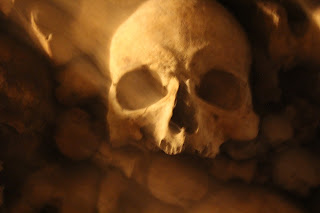Catacombs of Paris
Today six million people are buried under the city of Paris in old limestone quarries and the tunnels that connected them. City officials were forced to make this decision to dig up and relocate the dead when the city's cemeteries became so full that they were overflowing, causing nearby buildings to cave in. Workers moved the dead into these empty quarries and tunnels every night for a couple of years.
Over time workers have attempted to artfully arrange the skeletal remains, as is evident in some of the photos here. The bones behind the facade are jumbled and go back into the shaft for many meters. The individuals are interred by cemetery and there are plaques noting which cemetery they are from. There is also an altar down there where rituals are performed for the dead.
If you want to go into the catacombs you must join a tour or wait for a couple of hours in a big line. The big line is cheaper, but you are wasting time that could be better spent eating macarons and drinking coffee in a cafe. Also, you must be able to walk down 100 or so steps into the mining tunnels. It is no place for you if you are at all claustrophobic, as the ceiling is low in places and the passageways are narrow. Don't wear your best shoes down into the catacombs, there are lots of limestone laced puddles there, and Andrea ruined a pair of shoes.
The catacombs are a big empty hole under the streets of modern day Paris, therefore the ground in this area of the city is not stable and buildings have been known to collapse into the tunnels. When you are in the catacombs they show you the measuring devices taped to the cracks in the ceiling above your head. This is how they measure which cracks are getting larger over what period of time.
We had a great time looking for non metric variables on crania, and found lots of retained metopic sutures. I know not many of you care about these things, but Andrea and I had a blast.
More soon.





Two peas in a pod ENJOY
ReplyDeleteAccording to Wikipedia: "The secondary burial is a feature of certain prehistoric grave sites of all types, identified since the New Stone Age, which is a frequent feature of megalithic tombs and tumuli. Secondary burials were also a mortuary custom among many Native American cultures."
ReplyDeleteHmmm... looks like they also did it in Paris, and in modern day Greece and even New Orleans!